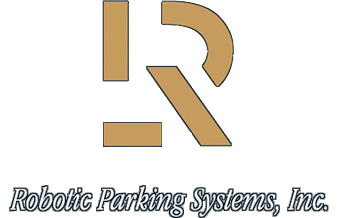Key questions that any owner / developer / architect should ask.
For an owner or developer, choosing the right automated parking system and supplier can avoid costly mistakes.
Automation in principle is not rocket-science. A rack and rails automated parking system uses principles, still in use today, that were implemented with locomotives about 200 years ago. Elevators have been used for more than 100 years. Automation components introduced in the 1980s have advanced significantly and have proven to be reliable if chosen from reputable world class companies.
There are automated parking systems with long successful track records – ask questions, look at them carefully and make an informed decision. Here are some key questions. The bottom line is do your due diligence and LOOK don’t LISTEN.
1. Is the automated parking product engineered, developed and manufactured in the US?
In 1994, Robotic Parking Systems Inc. coined the term “robotic parking” and established the Florida-based company that designed, manufactured, and installed what was certified as the largest robotic parking garage in the world. The company’s lift-and-run system, integrating mechanical capability with software control, was a monumental breakthrough in the parking industry.
2. Is a long-term system warranty with operations and maintenance agreement offered?
Robotic Parking Systems is the first and only known automated parking vendor to offer a 10+ year guarantee on its system when paired with an operating and maintenance agreement. This ensures optimal long-term performance.
3. Is the system “fit for purpose”? Is “standard of care” observed? Can the system deliver the throughput required by the project?
According to the National Parking Association, “The most important factor for designing the access requirements for any parking facility is to determine the peak-hour arrival and departure traffic volume.”
In the standard of care directive, a design professional has the responsibility or duty that anything that is designed needs to be “fit for the intended purpose of use.” In the automatic parking industry, it means that s/he has the obligation to make sure the associated required peak traffic capacity for a specified automated garage is in accordance with industry standards.
For the Robotic Parking System, TUV witnessed the throughput, visually inspected and functionally tested the system. TUV attested that the system was safe to operate for its intended use and meets the contract design specifications.
4. Has the required throughput been achieved by the company in previous projects and was the system’s peak traffic verified by a third party?
The operational efficiency of Al Jahra Court’s Robotic Parking System is truly remarkable. In independent tests conducted by TUV, the facility achieved a peak traffic throughput of 425 cars per hour, facilitated by 12 grade-level entry/exit bays strategically positioned throughout the garage. This translated to an astonishing capacity to process nearly 7 cars every minute, providing a swift and seamless parking experience for users. Notably, the performance of the system surpassed the contract requirements, with throughput exceeding the stipulated 400 cars per hour and an average single retrieval time of 177 seconds, showcasing the robustness and reliability of the technology.
5. Has any automated parking project delivered by the company resulted in any insurance claims or lawsuits in the last 10 – 15 years?
Robotic Parking Systems Inc has had no insurance claims or lawsuits against the company in the last 10 – 15 years.
6. Can the automated parking system software be optionally escrowed to ensure future viability if the vendor goes out of business?
All automated parking systems require software to operate. Most vendors do not offer an option by which the owner has a recourse in case the system supplier defaults on its obligations, effectively rendering the system compromised or, even worse, useless.
Robotic Parking Systems offer an optional software licensing combined with an escrow agreement in which the source code is put into the safekeeping of a third-party escrow agent. This gives owners a high level of operational security.
7. Does the vendor offer optional specialized fire suppression handling for EV fires?
Car fires in a parking garage threaten human life, and represent potential catastrophic damage to hundreds or thousands of vehicles as well as the garage infrastructure itself.
Robotic Parking Systems offer a revolutionary fire safety solution called the FIRE BOX, an optional addition to the automated parking system. Unlike traditional firefighting methods, the FIRE BOX aims to prevent a fire from escalating (spreading to other vehicles) by swiftly relocating the vehicle to a safe, controlled environment. Robotic Parking offers the first “fire safe” garage in the world.
8. Is the technology patented to prevent infringement lawsuits?
Robotic Parking Systems Inc. holds multiple US patents for its automated parking system.
9. Can the system handle car sizes up to 19 ft (5,790 mm) long, 88 in (2235 mm) wide and 6,600 lbs. (3,000 kg) weight?
Robotic Parking Systems’ roomy terminals accommodate large SUVs up to 88 in wide and 19 ft long. High weight capacity means the system can park even the 6,500 lb. Yukon XL. Pallet technology allows parking cars with low clearance without damaging the undercarriage.
10. Was the “reasonable alternative design” (“RAD”) defect liability approach considered?
In product liability law, “product” includes “machinery,” a major component of Robotic Parking Systems’ garage design and technology. In terms of product liability, the “reasonable alternative design” (“RAD”) legal standard or test adopted in 1998, logically should be a recognized element in all parking garage liability lawsuits.
Robotic Parking Systems design and technology is inherently safer, and arguably “liability-proof” design. Such RAD evidence provides plaintiffs’ attorneys with a very sharp additional sword in seeking the judicial determination that concrete ramp garages are “not reasonably safe” under current legal standards, or that concrete ramp garages do not meet the accepted principles of “inherently safer design” when compared to the inherently safer Robotic Parking Systems design and technology.

